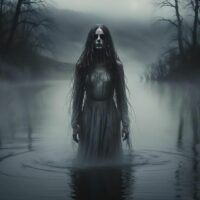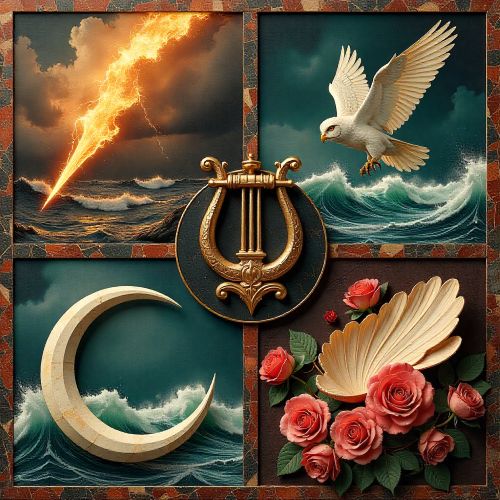Mul Gwishin : The Water Ghost
Listen
At a glance
| Description | |
|---|---|
| Origin | Korean Mythology |
| Classification | Ghosts |
| Family Members | N/A |
| Region | South Korea |
| Associated With | Water, Illusions, Kidnapping |
Mul Gwishin
Introduction
In the rich and often unsettling world of Korean mythology, few spirits are as chilling—or as misunderstood—as the Mul Gwishin. Translating directly to “water ghost,” these spectral beings are thought to be the souls of those who met a watery end, often under tragic or violent circumstances. Whether their bodies were never found or their deaths were shrouded in mystery, the Mul Gwishin remain tethered to the place of their demise, haunting rivers, lakes, and seas with an eerie, sorrowful presence.
These spirits serve as more than mere folklore. They represent the Korean cultural view on death, unresolved trauma, and the consequences of being forgotten. As both a cautionary tale and a ghost story, the Mul Gwishin continues to influence modern narratives while preserving its deep mythical roots.
Physical Traits
Visually, Mul Gwishin are the embodiment of the drowned and forsaken. Their features often reflect the cause of their death—wet, clingy hair drapes over faces sometimes devoid of distinct features, their skin ghostly pale or tinged blue from eternal submersion. They typically wear white garments, a color associated with mourning and funerals in Korean culture.
One of the most terrifying traits described in folklore is their motionless glide over water, seemingly unaffected by gravity or current. The aura they emit is unsettling and cold, a presence that sends shivers down the spine of anyone who senses it. Some variations portray them with elongated arms reaching out from beneath the surface, a desperate gesture to grab hold of the living.
Family
Unlike other supernatural entities that might exist in clans or under a deity’s command, Mul Gwishin are inherently solitary. This loneliness is not by choice but stems from abandonment. In Korean tradition, memorial rituals for the dead (jesa) ensure the spirit’s passage to the afterlife. Those who die in isolation—like drowning victims whose bodies are never recovered—often miss this essential rite. Their spirits, left in limbo, transform into Mul Gwishin.
The absence of surviving family or descendants to honor them adds another layer to their sorrowful existence. Unlike other types of gwishin such as the Cheonyeo Gwishin (virgin ghost), who may be mourned and remembered, the Mul Gwishin is often forgotten—making them even more restless and sometimes vengeful.
Other names
While they are most commonly called Mul Gwishin, these spirits are part of a broader classification system in Korean ghost lore. Gwishin can vary based on cause of death or life circumstances. Alongside the Mul Gwishin are the aforementioned Cheonyeo Gwishin, symbolic of women who died before marriage, and Dalgyal Gwishin, or egg ghosts, who are faceless and born out of ancestral neglect.
What sets the Mul Gwishin apart is their deep association with water and emotional unrest. While some water spirits across other mythologies are protectors or guardians, these beings are forever trapped in a cycle of death and longing.
Powers and Abilities
In the tales passed down through generations, Mul Gwishin are not passive figures—they are active agents of fear and tragedy. One of their most well-known abilities is the power to lure the living to a watery grave. It is said that they can mimic the cries of someone drowning or produce illusions of loved ones in distress, drawing rescuers into the same deadly fate.
They also manipulate their aquatic surroundings, cloaking entire areas in sudden fog or distorting reflections to disorient travelers. Their very presence near bodies of water is believed to cause unexpected accidents or unexplained drownings.
In some modern interpretations, particularly in video games or horror literature, Mul Gwishin are endowed with enhanced supernatural traits—such as casting frost-like spells, emitting paralyzing cold, or temporarily obscuring light. Though these embellishments are not traditional, they highlight how adaptable and enduring the spirit of Mul Gwishin is in the modern imagination.
Modern Day Influence
Despite originating from centuries-old traditions, the Mul Gwishin has not faded into obscurity. Instead, they have found a new home in Korea’s vibrant horror and pop culture scene. Their signature appearance—long, wet hair, pale face, and a deathly stillness—has inspired countless horror films, TV series, and webtoons.
Movies like Whispering Corridors and Dear Friend tap into this archetype, blending school horror with traditional ghost lore. The chilling image of the Mul Gwishin has also crossed borders, influencing similar ghost designs in Japanese and Chinese horror cinema. Even Western horror franchises borrow heavily from the Mul Gwishin aesthetic, particularly the idea of a vengeful, water-bound spirit returning for closure—or revenge.
Moreover, the Mul Gwishin has become an urban legend fixture. Korean teenagers dare each other to visit lakes rumored to be haunted, or recount late-night stories of phantom hands pulling swimmers underwater. Their tale is often used to instill caution about the dangers of swimming alone, especially at night.
Related Images
Source
Kim, Chongho. Korean Shamanism: The Cultural Paradox. London and New York: Routledge, 2018.
Yun, Kyoim. The Shaman’s Wages: Trading in Ritual on Cheju Island. Seattle: University of Washington Press, 2019.
Vaibhavi. (2023). Ghost Beliefs Among Koreans. https://www.koreanstudyjunkie.com/post/ghost-beliefs-among-koreans
Contributors to Wikimedia projects. (2009). Gwisin – Wikipedia. https://en.wikipedia.org/wiki/Gwisin
Gwishin, Mulgwishin – 5th Edition SRD. (2021). https://www.5esrd.com/database/creature/gwishin-mulgwishin/
Frequently Asked Questions
What is lorem Ipsum?
I am text block. Click edit button to change this text. Lorem ipsum dolor sit amet, consectetur adipiscing elit. Ut elit tellus, luctus nec ullamcorper mattis, pulvinar dapibus leo.
What is lorem Ipsum?
I am text block. Click edit button to change this text. Lorem ipsum dolor sit amet, consectetur adipiscing elit. Ut elit tellus, luctus nec ullamcorper mattis, pulvinar dapibus leo.
What is lorem Ipsum?
I am text block. Click edit button to change this text. Lorem ipsum dolor sit amet, consectetur adipiscing elit. Ut elit tellus, luctus nec ullamcorper mattis, pulvinar dapibus leo.
What is lorem Ipsum?
I am text block. Click edit button to change this text. Lorem ipsum dolor sit amet, consectetur adipiscing elit. Ut elit tellus, luctus nec ullamcorper mattis, pulvinar dapibus leo.
What is lorem Ipsum?
I am text block. Click edit button to change this text. Lorem ipsum dolor sit amet, consectetur adipiscing elit. Ut elit tellus, luctus nec ullamcorper mattis, pulvinar dapibus leo.





